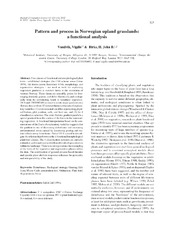| dc.contributor.author | Vandvik, Vigdis | eng |
| dc.contributor.author | Birks, Harry John Betteley | eng |
| dc.date.accessioned | 2006-04-27T09:56:23Z | |
| dc.date.available | 2006-04-27T09:56:23Z | |
| dc.date.issued | 2002 | eng |
| dc.Published | Journal of Vegetation Science 2002 13:123-134 | |
| dc.identifier.issn | 1100-9233 | en_US |
| dc.identifier.uri | http://hdl.handle.net/1956/1160 | |
| dc.description.abstract | Four classes of functional and morphological plant traits (FMT) – established strategies (the CSR scheme sensu Grime 1979), life-forms (sensu Raunkiaer 1934), morphology, and regenerative strategies – are used as tools for explaining vegetation gradients at summer farms in the mountains of western Norway. These farms are assembly points for free-ranging domestic grazers, and differ floristically and ecologically from the surrounding heath or woodland vegetation. Detrended Correspondence Analysis and Two-Way INdicator SPecies ANalysis are used to relate major gradients in a floristic data set from 12 summer farms to two sets of explanatory variables: (1) environmental variables representing physical factors, plot position, soils, and land-use, and (2) the four FMT classification schemes. The main floristic gradient parallels a spatial gradient from the centres of the farms to the surrounding vegetation. A functional interpretation based on the concurrent use of the two sets of explanatory variables suggests that the gradient is one of decreasing disturbance and increasing environmental stress caused by decreasing grazing and manure effects away from farms. Partial Canonical Correspondence Analysis is used to investigate the relationships between the four FMT classes. The four classification schemes are partially redundant, and do not represent different trends of specialisation within the landscape. There is no strong evidence for decoupling of the traits of the vegetative and regenerative phases within the data. The combination of general process-based theories and specific plant attribute responses enhances the generality and interpretability of the study. | en_US |
| dc.format.extent | 265105 bytes | eng |
| dc.format.mimetype | application/pdf | eng |
| dc.language.iso | eng | eng |
| dc.publisher | Opulus Press | en_US |
| dc.subject | Disturbance | eng |
| dc.subject | Ecological strategies | eng |
| dc.subject | Grazing | eng |
| dc.subject | Life-forms | eng |
| dc.subject | Monte Carlo permutation tests | eng |
| dc.subject | Ordination | eng |
| dc.subject | Plant traits | eng |
| dc.subject | Regeneration | eng |
| dc.subject | Stress | eng |
| dc.title | Pattern and process in Norwegian upland grasslands: a functional analysis | en_US |
| dc.type | Peer reviewed | |
| dc.type | Journal article | |
| dc.subject.nsi | VDP::Matematikk og Naturvitenskap: 400 | nob |
